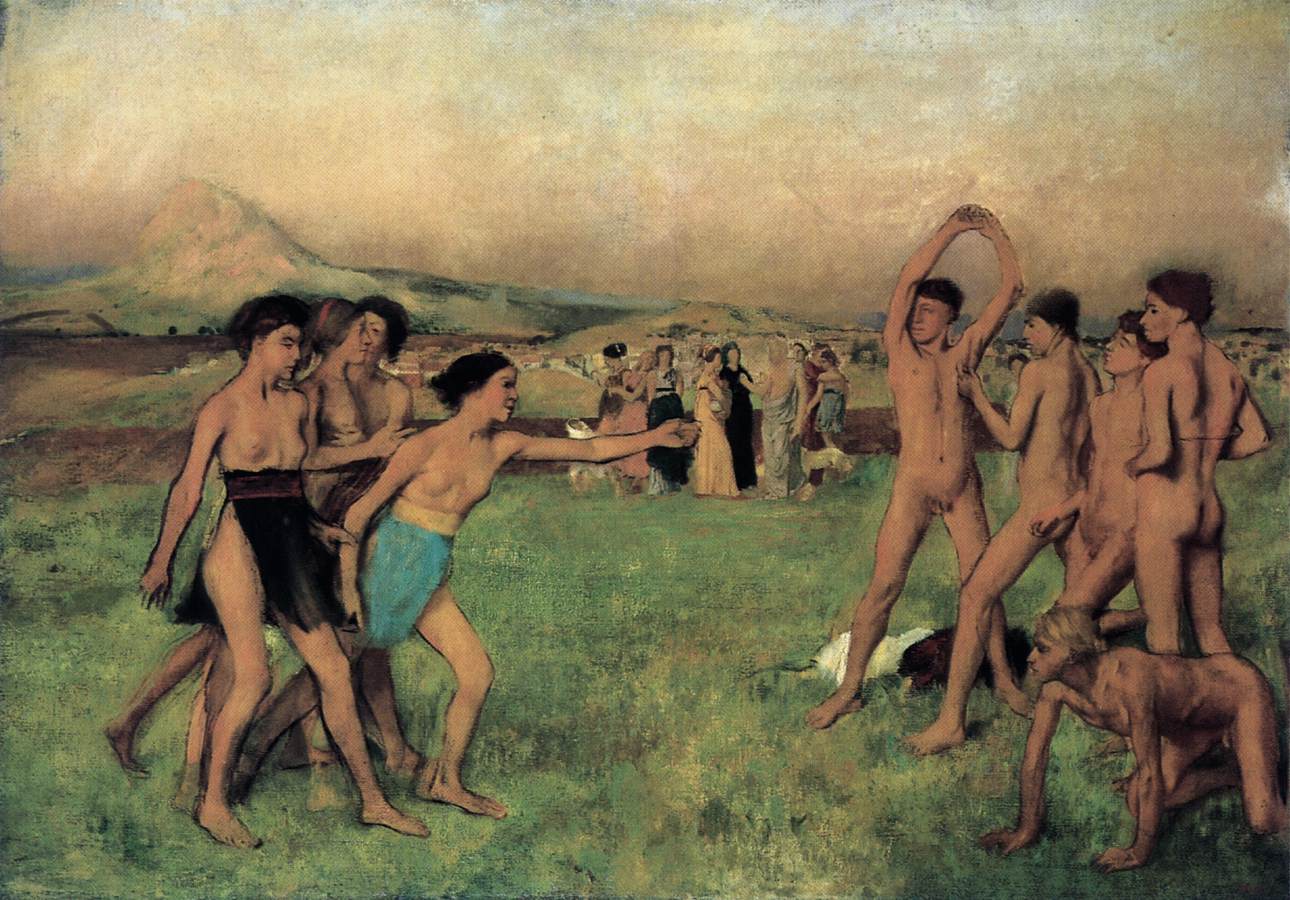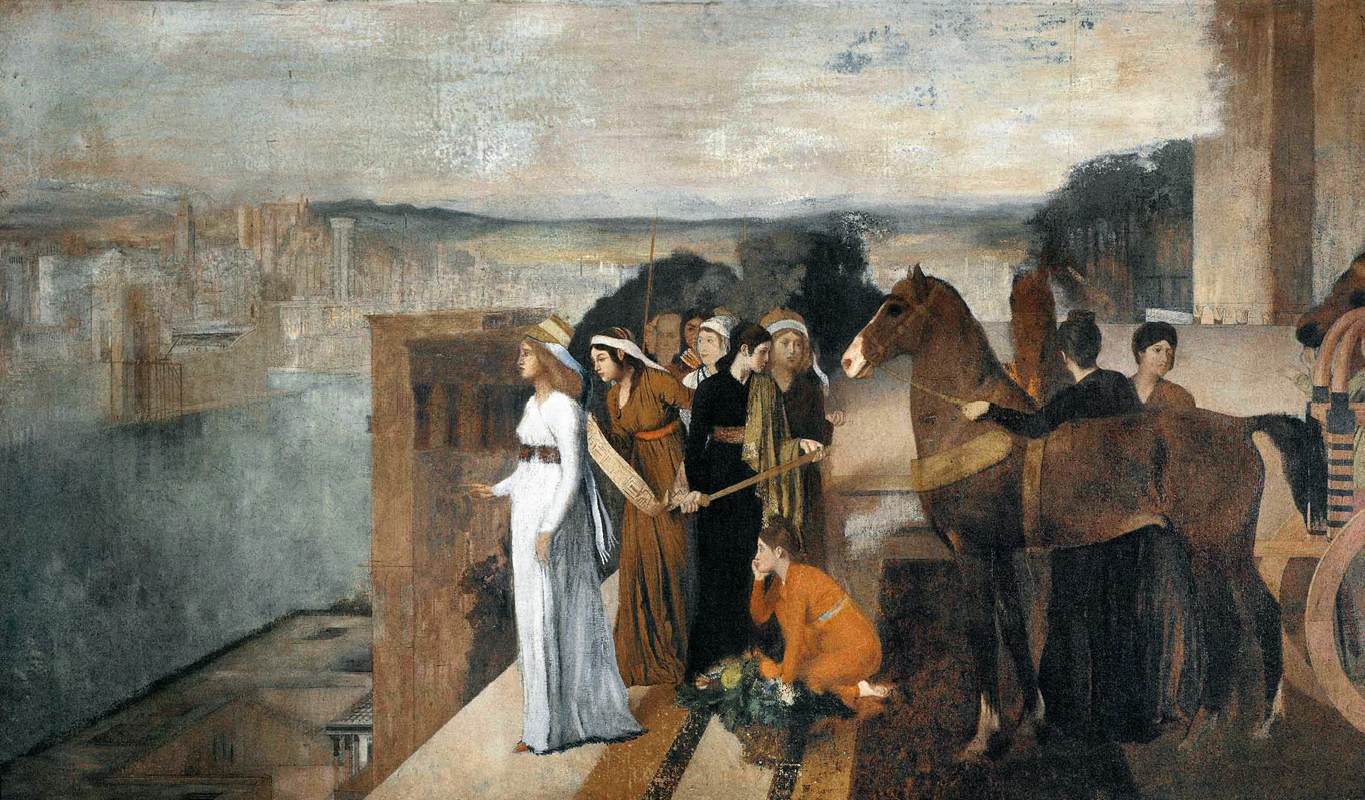French painter and sculptor. He was born Hilaire-Germain-Edgar de Gas into a wealthy banking family. His father, Pierre-Auguste-Hyacinthe de Gas was a manager of a branch of private bank belonging to Edgar's grandfather in Naples. His mother, Célestine Musson, was of Creole descent and came from New Orleans. Although prepared for the law, he abandoned it for painting, studying from 1853 to 1855 at the École des Beaux-Arts with Louis Lamothe and Hippolyte Flandrin, who passed on their valuable expertise on the works of Ingres.
His first trip to Italy was in 1856-59. He visited Naples where his paternal grandfather lived, then Florence, where his aunt, Baroness Bellelli, and cousins lived. He started here the Portrait of the Bellelli Family. He studied the early Renaissance masters and met the painters known as the Macchiaioli.
Returning to France, in 1860 he stayed with the Valpinçons in Normandy. He was particularly interested in historical painting: Jephthah's Daughter, Young Spartans Exercising. He made his first studies of horses and riders.
His long-standing friendship with Manet began in 1862. Through Manet, whom he met at the Louvre, he made the acquaintance of Renoir, Monet, and Zola. Between 1865 and 1870 he exhibited in the Salon, but later ceased showing there and exhibited with the Impressionists, whose works he admired although his approach often differed from theirs. His first entry at the Salon was The Sufferings of the City of New Orleans, while his last the Portrait of Madame Camus.
Between 1865 and 1870 he painted a series of portraits, first of isolated figures, then of groups. In 1868 he painted his first paintings of dancers, in 1869 the first paintings on the theme of laundress.
During the Franco-Prussian War in 1870-71 he served in the National Guard in Paris, and he was in Normandy during the Commune. In 1872-73 he traveled to New Orleans and painted The Cotton Exchange in New Orleans. In 1873 Degas with others founded the "Société anonyme" to organize independent, unjuried exhibitions.
In 1874 he contributed ten works to the first Impressionist exhibition, and in 1876 twenty-four works to the second exhibition, including Woman Ironing and Absinthe Drinkers. To the third Impressionist exhibition in 1877 he contributed twenty-two prints, drawings, monotypes and paintings.
In 1876 Degas sold his collection of paintings to help the family avoid bankruptcy. He gave most of his assets to his brothers and began having serious financial difficulties. He started painting fans for commercial purposes. To the fourth Impressionist exhibition in 1879 he contributed fans, and oil and pastel work.
At the fifth Impressionist exhibition in 1880 he presented eight paintings and pastels, including the Portrait of Duranty, then in next year to the sixth exhibition he contributed several pastels and the almost life-size wax sculpture Little Fourteen-Year-Old Dancer.
In 1882 Degas made several pastels on the theme of the milliner, again took up the theme of women ironing, and created his first important depictions of a woman at her toilet.
At the last Impressionist exhibition in 1886 he showed five oils and ten pastels, a series of women at their toilet. After this date he stopped exhibiting pictures, selling them on contract through Durand-Ruel.
From 1865 Degas experimented with sculpture and he modeled more and more as his eyesight declined, making sculptures of ballerinas and horses. He created a number of wax figures not intended for public display, they were in fact not cast in bronze until after his death.
In 1893-95 his eyesight worsened, 1n 1898-1908 he became progressively blind and led a solitary life. He became unable to draw and paint. He died in 1917 and was buried in the Montmartre cemetery in Paris.
In addition to his first trip to Italy, Degas traveled several times to Italy (1873, 1875, 1886), Spain (1880, 1882, 1889), Morocco (1889).
Assessment
An unflagging perfectionist, Degas strove to unite the discipline of classical art with the immediacy of Impressionism. Trained in the linear tradition of Ingres, Degas shared with the Impressionists their directness of expression and the interest in and portrayal of contemporary life. His favourite subjects were ballet dancers, women at their toilet, café life, and race-track scenes. He made notes and sketches from living models in motion to preserve informality of action and position. From these he organized his finished work in the studio, not directly from nature as his contemporaries did. Moreover, he created many daring compositional innovations. Influenced by Japanese prints and especially by photography, Degas diverged from the traditional ideas of balanced arrangements. He introduced what appeared to be accidental cutoff views, off-centre subjects, and unusual angles, all quite carefully planned.
Degas's main interest was the human - and in particular the female - form, to him, its poses and movements were synonymous with perfection and harmony. The way he treated space and light in his works depicting jockeys, dancers, and washerwomen (which from the late 1870s he produced primarily in watercolours) was what differentiated his output from classic images and identified his proximity to Neo-Impressionism.
//
![]()









